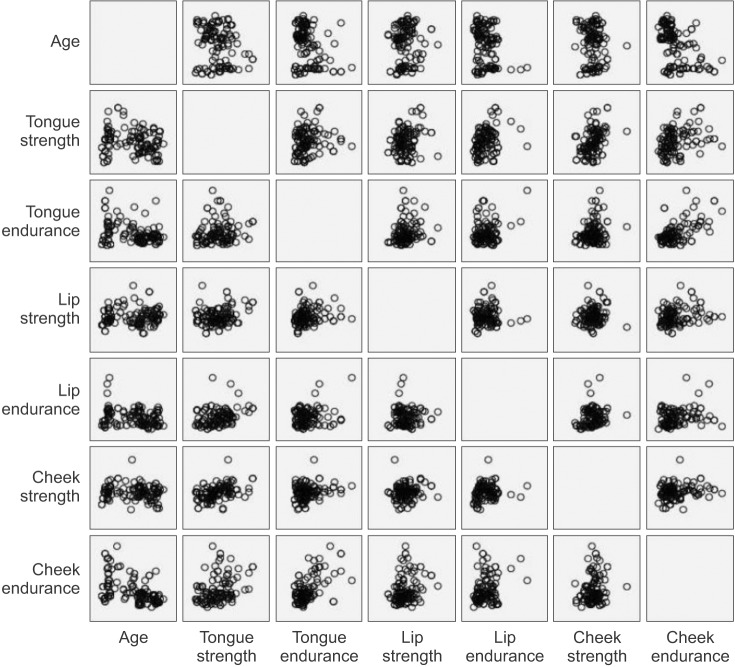J Korean Assoc Oral Maxillofac Surg.
2017 Aug;43(4):221-228. 10.5125/jkaoms.2017.43.4.221.
Maximal strength and endurance scores of the tongue, lip, and cheek in healthy, normal Koreans
- Affiliations
-
- 1Department of Oral and Maxillofacial Surgery, School of Dentistry, Seoul National University, Seoul, Korea. leejongh@snu.ac.kr
- 2Clinical Translational Research Center for Dental Science, Seoul National University Dental Hospital, Seoul, Korea.
- 3Department of Oral and Maxillofacial Surgery, Korea University Guro Hospital, Seoul, Korea.
- 4Dental Research Institute, Seoul National University, Seoul, Korea.
- KMID: 2391352
- DOI: http://doi.org/10.5125/jkaoms.2017.43.4.221
Abstract
OBJECTIVES
The purpose of this study was to establish normative data for healthy Korean adults by measuring the maximal strength and endurance scores of the tongue, lip, and cheek, and to examine correlations between these measurements.
MATERIALS AND METHODS
This study included 120 subjects that were divided into three groups according to age: young (20-39 years), middle-aged (40-59 years), and older (over 60 years); and by gender. Measurements were taken using the Iowa Oral Performance Instrument (IOPI).
RESULTS
The mean maximal tongue strengths were as follows: young men (46.7±10.2 kPa) and women (32.1±7.9 kPa), middle-aged men (40.9±9.3 kPa) and women (36.9±8.6 kPa), and older men (35.2±9.0 kPa) and women (34.5±6.9 kPa). The mean tongue endurance scores were: young men (28.8±12.6 seconds) and women (20.8±13.5 seconds), middle-aged men (17.0±8.5 seconds) and women (15.3±5.2 seconds), and older men (15.8±6.7 seconds) and women (17.9±8.1 seconds). The mean maximal lip strengths were: young men (11.6±3.0 kPa) and women (11.4±3.8 kPa), middle-aged men (11.4±4.2 kPa) and women (11.1±5.1 kPa), and older men (14.5±3.9 kPa) and women (11.7±2.6 kPa). The mean lip endurance scores were: young men (41.1±23.9 seconds) and women (22.4±21.7 seconds), middle-aged men (24.3±10.3 seconds) and women (30.5±13.4 seconds), and older men (24.9±11.0 seconds) and women (12.8±7.6 seconds). The mean maximal cheek strengths were: young men (24.5±4.6 kPa) and women (20.5±4.3 kPa), middle-aged men (25.2±6.4 kPa) and women (21.2±5.5 kPa), and older men (22.4±5.3 kPa) and women (18.0±4.8 kPa). The mean cheek endurance scores were: young men (47.8±24.4 seconds) and women (43.9±25.0 seconds), middle-aged men (27.3±11.3 seconds) and women (20.0±14.6 seconds), and older men (21.7±14.5 seconds) and women (17.2±11.4 seconds).
CONCLUSION
The data collected in this study will provide an important database of standardized measurements for maximal strength and endurance scores of the tongue, lip and cheek in healthy, normal Koreans.
Keyword
Figure
Cited by 1 articles
-
Squamous cell carcinoma of lower lip: the results of wide V-shaped resection
Sung Bin Youn, Hoon Myoung, Ik-Jae Kwon
J Korean Assoc Oral Maxillofac Surg. 2023;49(5):292-296. doi: 10.5125/jkaoms.2023.49.5.292.
Reference
-
1. Logemann JA. Evaluation and treatment of swallowing disorders. San Diego: College-Hill Press;1983.2. Robin DA, Somodi LB, Luschei ES. Measurement of strength and endurance in normal and articulation disordered subjects. In : Moore CA, Yorkston KM, Beukelman DR, editors. Dysarthria and apraxia of speech: perspectives on management. Baltimore: Paul H. Brookes;1991. p. 173–184.3. Clark HM, Solomon NP. Age and sex differences in orofacial strength. Dysphagia. 2012; 27:2–9. PMID: 21350818.
Article4. Vitorino J. Effect of age on tongue strength and endurance scores of healthy Portuguese speakers. Int J Speech Lang Pathol. 2010; 12:237–243. PMID: 20433342.
Article5. Vanderwegen J, Guns C, Van Nuffelen G, Elen R, De Bodt M. The influence of age, sex, bulb position, visual feedback, and the order of testing on maximum anterior and posterior tongue strength and endurance in healthy belgian adults. Dysphagia. 2013; 28:159–166. PMID: 22983359.
Article6. Yoshikawa M, Yoshida M, Tsuga K, Akagawa Y, Groher ME. Comparison of three types of tongue pressure measurement devices. Dysphagia. 2011; 26:232–237. PMID: 20623302.
Article7. Lazarus C, Logemann JA, Huang CF, Rademaker AW. Effects of two types of tongue strengthening exercises in young normals. Folia Phoniatr Logop. 2003; 55:199–205. PMID: 12802092.
Article8. Stierwalt JA, Youmans SR. Tongue measures in individuals with normal and impaired swallowing. Am J Speech Lang Pathol. 2007; 16:148–156. PMID: 17456893.9. Crow HC, Ship JA. Tongue strength and endurance in different aged individuals. J Gerontol A Biol Sci Med Sci. 1996; 51:M247–M250. PMID: 8808997.
Article10. Kays SA, Hind JA, Gangnon RE, Robbins J. Effects of dining on tongue endurance and swallowing-related outcomes. J Speech Lang Hear Res. 2010; 53:898–907. PMID: 20689047.
Article11. Johnson LR. Orofacial strength and endurance in skilled trumpet players. Washington State University;2013.12. Robin DA, Goel A, Somodi LB, Luschei ES. Tongue strength and endurance: relation to highly skilled movements. J Speech Hear Res. 1992; 35:1239–1245. PMID: 1494269.13. Lazarus CL, Logemann JA, Pauloski BR, Rademaker AW, Larson CR, Mittal BB, et al. Swallowing and tongue function following treatment for oral and oropharyngeal cancer. J Speech Lang Hear Res. 2000; 43:1011–1023. PMID: 11386468.
Article14. Lazarus C, Logemann JA, Pauloski BR, Rademaker AW, Helenowski IB, Vonesh EF, et al. Effects of radiotherapy with or without chemotherapy on tongue strength and swallowing in patients with oral cancer. Head Neck. 2007; 29:632–637. PMID: 17230558.
Article15. Van Lierde KM, Bettens K, Luyten A, Plettinck J, Bonte K, Vermeersch H, et al. Oral strength in subjects with a unilateral cleft lip and palate. Int J Pediatr Otorhinolaryngol. 2014; 78:1306–1310. PMID: 24882455.
Article16. Lee KH, Sim HS, Kim HH. Tongue strength, range of motion, and speech intelligibility in dysarthric speakers. Speech Sci. 2005; 12:89–99.
- Full Text Links
- Actions
-
Cited
- CITED
-
- Close
- Share
- Similar articles
-
- Analysis of Correlation among Oral Environment, Oral Myofunction, and Oral Microorganisms
- Cervical proprioception in Parkinson's disease and its correlation with manual dexterity function
- The Effects of Orofacial Myofunctional Training on the Changes of Lip and Tongue Strength in Elderly People
- Correlations between orbicularis oris and mentalis muscle activity and craniofacial morphology in normal occlusion and Class III malocclusion
- Association of Post-extubation Dysphagia With Tongue Weakness and Somatosensory Disturbance in Non-neurologic Critically Ill Patients



